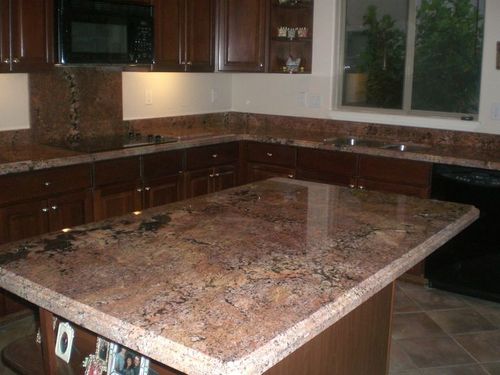SELECT PREMIUM
10 Steps to a perfect project.
Step 1: Introduction – Your initial introduction is what gives you the confidence to choose a particular company. The introduction should include a clear description of the process and a brief education of stone, especially if this is your first stone experience. Do not ask for a price at this time, if given it will usually appear low and there is no way someone can account for every detail of the installation without inspecting it. Some homeowners want a price per square foot first, yet this is not the logical way to give an estimate. At this time there are too many variables to provide and accurate estimate.
Step 2: Your Drawing - Make a simple, legible drawing of your kitchen or bath with measurements. Include what kind of backsplash you want and where sink placements are located. If you know the edge shape you want, also include this information. Send this by fax or email to your fabricator as soon as possible.
Step 3: Preliminary Estimate - A preliminary estimate should be given at this time so you can decide if you want to move forward with the work. Keep in mind prices can still change depending on the difficulty of the installation, the type of stone chosen and the edge shape you decide to go with. If the installer says this is the final price…beware! If the installation requires more work than anticipated, the results will be compromised, and that’s a guarantee you can count on. As with most construction projects, change orders and price adjustments are to be expected.
Step 4 – Choosing Your Stone – Stone selection is one of those steps you either enjoy or you wish it was over already. Picking out stone is just like shopping; you either love it or hate it. Marital tip #1 – If your spouse doesn’t like shopping, don’t take them. Picking out the right stone takes time and patience. We recommend carving out several hours and walking the yards to narrow down a color range. Ask the salesman to explain the unique characteristics of the stones you chose. Tell them you want to know as much as possible about the stone, good or bad, so you can make an educated decision. Bringing your cabinet door helps to visualize the contrasting colors. Choosing a yard with excellent stone knowledge and a designer touch can make a big difference in the end. If you want more information about the stone you are interested in or you are indecisive about a particular stone, call us at (602) 278-9544. Our years of experience can help you make a better decision.
Step 5 – Layout - In order to see what the stone will look like in your kitchen, it must be laid out according to your measurements or the template. A layout is when you mark off the stone based on the measurements. The fabricator will then cut your stone according to those marks. Layouts can be done in the stone yard or in the fabricators shop. You are the one who will be looking at the stone every day and therefore you are responsible for final decision how the stone will lay out. You only want to work with companies who are willing to let you decide how it will lay out. If you decide to leave this important decision up to the fabricator, then you have no room to criticize where they set the slabs after the stone is installed.
Step 6: Templating - Templating is creating the exact measurements of your countertop for cutting and fabrication. During the templating step you will share your ideas and express your concerns. The templator must answer all your questions regarding the process but may not be aware of time frames or costs. You will need to have your sink chosen by now. Usually, you will at this time give the sink or the paper template to the templater.
Step 7: Final Estimate – Now that you have chosen the stone and the templator has measured and inspected the job, a final estimate should be provided. This estimate will include all the details of the job and payment schedule. Prices range from one fabricator to the next, but the range is usually only off a few hundred dollars or so for the average kitchen. If you trust your fabricators work and like them, do not try to find someone to beat their cost. Usually you can find a company with a lower estimate but it will wind up costing you more in the end. Some kitchens are extremely complicated and challenging thus requiring the best in the business to tackle such a project.
Step 8 – Fabrication - Fabrication includes the cutting and shaping of the slab according to your requests and template. Some fabricators use sophisticated water jet systems while others use hand tools. Both methods produce excellent results when the right stone technician is doing the work.
Step 9: Installation - A team of installers carefully lift and set the stone pieces into place. They modify and customize the stone and sub-top to fit the stone just right. Many uncontrollable issues can come up for the installer at this time. It is important they inform you of unresolved problems soon after they occur.
Step 10: Sealing - The final step is to have the stone professionally inspected, cleaned, detailed and sealed with a service warranty. This process removes any topical residue and improves the over-all appearance of the stone. After cleaning the stone, several applications of penetrating sealer should be applied to help prevent staining and discoloration.
